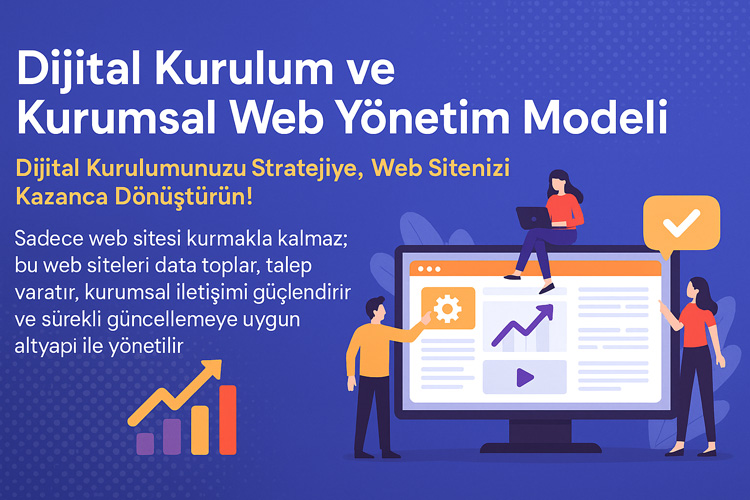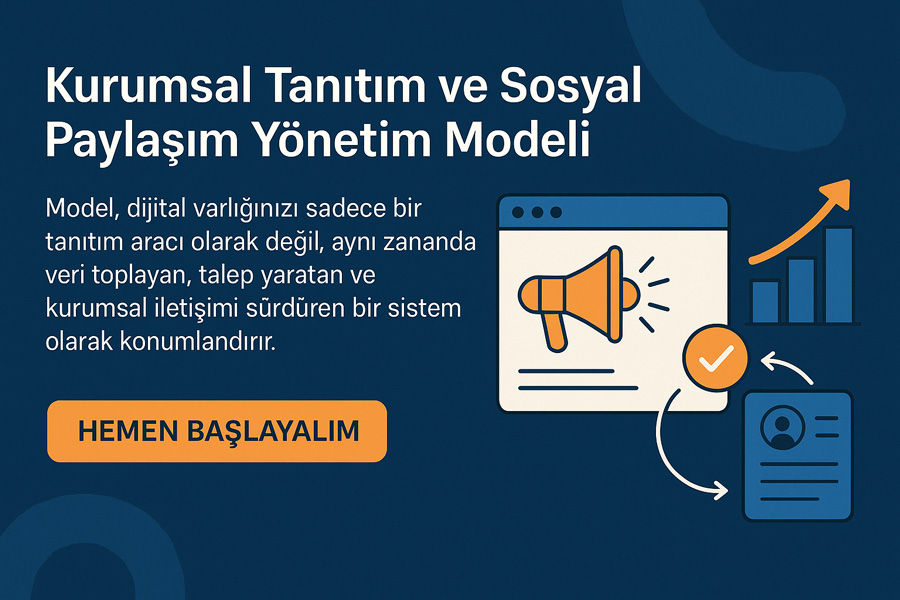Today, many people dream of being their own boss. However, the way to turn this dream into reality is through a planning process based on solid foundations. Especially for entrepreneurs who want to establish a small business, it is of great importance that the steps to be taken are clear and applicable. Because this scale offers rapid growth potential when managed correctly; however, if it proceeds with an incomplete or scattered structure, it can put the business in a difficult position at the beginning. Therefore, proper planning and a strategic roadmap are essential for a successful enterprise.
A small business usually starts with limited capital, operates with fewer employees and focuses on a specific market. However, this does not mean that its potential is limited. On the contrary, thanks to its flexible structure, it can adapt to market dynamics more quickly, manage customer relations more personally and be more open to innovation. These features accelerate the growth process of small but effective businesses.
In this article, we will take a step-by-step look at the process of establishing a small business. We have simplified many critical steps for you, from determining the business idea to market analysis, from company establishment to digital marketing strategies. Technical issues such as legal processes, financial planning and operational infrastructure will also be detailed, especially for those who want to start from scratch. Thus, this content will be a comprehensive resource for both those who will experience entrepreneurship for the first time and those who want to grow their business systematically.

If you are on your way to becoming a small business owner and don’t know where to start, this guide will guide you. If you are ready, let’s explore step by step how to establish your business, starting from the first step. Remember: Every big brand was once a small business. Maybe yours will be the next success story. 🚀
İçindekiler
ToggleBusiness Idea and Planning Process
A solid idea and a strategic planning process lie at the core of every successful venture. For anyone who wants to start a small business, this first stage is critical enough to determine the fate of the entire business. Because a business idea should be evaluated not only with its potential to make money, but also with its sustainability and personal harmony. Especially for entrepreneurs who set out with limited resources, it is essential to use values such as time, energy and money correctly. Therefore, the time allocated to planning is never wasted; on the contrary, it ensures the success of the business.
When establishing a small business, the first thing to do is to determine a business idea that suits your interests and abilities and is in demand in the market. Starting a business just because it is trendy can lead to loss of motivation and risk of loss over time. Instead, determining a field based on one’s own experiences, skills and passions will yield more permanent results. Of course, not only individual factors; the real needs of the market should also be taken into account. At this point, it is possible to create opportunities based on local needs, missing services or consumer demands.
Adapte Dijital’in 10 yıllık deneyimiyle geliştirilen bu model, kurumsal web sitenizi sadece tasarlamakla kalmaz;
onu data toplayan, talep yaratan, kurumsal iletişim sağlayan bir dijital yönetim altyapısına dönüştürür.
Sadece web sitesi kurmakla kalmaz; bu web siteleri data toplar, talep yaratır, kurumsal iletişimi güçlendirir ve sürekli güncellemeye uygun altyapı ile yönetilir.
After the small business idea is clear, it is necessary to prepare a business plan. This plan should include your business model, target audience, income-expense estimates and competitor analysis. At the same time, a SWOT analysis that clearly reveals your strengths and weaknesses should also be included in this process. A business plan is a reassuring document not only for the business owner, but also for investors and official institutions.
As a result, the planning phase in the process of establishing a small business is the backbone of the entire system. A structure that is not based on solid foundations can collapse at the first wind. Therefore, let’s talk in detail about how to find the right business idea and how to turn this idea into a planned structure.

Choosing the Right Business Idea
The first and perhaps most important step in starting a small business is to determine the business idea that suits your personal competencies, market needs, and resources. Turning to a business idea just because it’s trendy can drain your motivation and resources in the long run. Therefore, it is important to make a decision by recognizing your true potential and analyzing your environment. Below, we will touch on three critical subheadings that will help you manage this process correctly.
Business Areas That Suit Your Interests and Competencies
If you want to establish a successful small business, you should start by getting to know yourself. What jobs do you not notice how time flies when you do them? In which areas are you naturally more competent? These questions will help you determine your areas of interest and skill. For example, if your manual skills are strong, workshop-type jobs or production-based ideas may be more suitable for you. On the other hand, if you are familiar with the digital world, you can establish small but effective initiatives in areas such as content production and social media consultancy. Without knowing your own strength, it is difficult to achieve success no matter how strong the market is.
Developing Ideas According to Market Needs
You need to analyze the needs of the market you are in as well as your own skills. A service or product that is not in demand will not be sustainable, no matter how good it is. You can shape your small business idea by analyzing gaps such as services missing in the local market, fast delivery solutions, and regional production demands. Market research, competitor analysis, and customer surveys provide you with clear data at this stage. This way, you will both meet a real need and gain a competitive advantage.
Getting Inspired by Existing Small Business Examples
Don’t underestimate the power of inspiration. Examining successful small business examples in Turkey and around the world can help you create your own roadmap. Models such as boutique coffee shops, handmade product sellers, and online education initiatives in particular offer both low capital and flexible working opportunities. You can materialize your own business idea through the success stories, challenges, and strategic moves of these businesses. Someone else’s success model can be a completely different success when you adapt it.
Business Plan and Strategic Preparation
Having a business idea is a great step to start, but turning it into a success requires a solid plan. For small business owners, planning is not just a paperwork; it is a process of sustainability, growth, and being prepared for times of crisis. A well-designed business plan gives your business both direction and confidence. Under this H3 heading, we detail 3 important stages that small businesses should consider during the strategic preparation process.
Creating a Business Model (BMC, SWOT, Goals)
The cornerstone of business planning is to clearly define the business model. One of the most preferred methods for this is the Business Model Canvas (BMC) system. Thanks to this approach, you can see all the building blocks from your customer segment to your revenue stream in a single diagram. At the same time, you can clearly reveal your strengths and weaknesses, opportunities and threats by performing a SWOT analysis. 📊 Thanks to these strategic tools, you can evaluate your small business idea according to both internal and external factors. Determining your goals and planning how to achieve them makes the process concrete.
Adapte Dijital’in 10 yıllık deneyimiyle geliştirilen bu model, kurumsal web sitenizi kurumunuzu/markanızı anlatan, tanıtan, güven yaratan, talep oluşturan bir dijital yönetim platformuna dönüştürür.
Adapte Dijital, bu modelde bir konumlandırma ajansı olarak çalışır. Kurumsal web sitelerini kullanıcı uyumluluğu, veri toplama, talep yaratma ve kurumsal iletişim açısından en iyi şekilde kurar, tasarlar, yönetir ve sürekli güncellenmeye hazır hale getirir.
Determining Target Audience and Value Proposition
Who is your target audience? What do you offer them? If you don’t have a clear answer to these two questions, it is difficult for your business to last long. Because every successful small business produces a solution specific to a specific customer group. This solution is your “value proposition”. In other words, the difference, convenience, quality or emotion you offer to the customer… Determining your target audience both helps you create your marketing strategy and shapes your product/service design. Your value proposition is the most powerful tool that sets you apart from your competitors.
Competitor Analysis and Positioning
Accepting that you are not alone in the market makes you strong. By analyzing your competitors, you can benefit from their strengths and differentiate yourself in areas where they are weak. Sectoral research, local market observations and digital tools can be used to conduct competitor analysis. 🔍 As a result of this analysis, it becomes clear how you should position yourself in the market as a small business: Are you cheap and fast? Are you quality and special? Are you targeting loyal customers or large masses? All of these answers will determine your positioning and strategy.
The Establishment Process and Legal Steps
One of the most exciting steps in the journey of establishing a small business is the process of formalizing your idea and turning it into a real business. However, this step is also the most confusing and questionable stage for many entrepreneurs. Because choosing a company type, tax obligations, license processes and other official procedures can strain entrepreneurs’ time, energy and often motivation. That’s why it’s so important to have a clear, step-by-step roadmap before you start the establishment process.
First, you need to decide what type of company you want to establish. When choosing between a sole proprietorship, limited liability or joint stock company, you need to consider not only your current but also your future plans. Because the right structure will put your business on a healthier footing in terms of tax advantages, areas of responsibility and growth potential. The sole proprietorship model, which is especially suitable for the small business format for beginners, stands out due to its low cost and flexibility.
The establishment process is not limited to the type of company. Depending on the sector you will operate in, you may need chamber registration, tax number, SGK transactions, business license and, in some cases, environmental, health or safety documents. Preparing these documents in a timely and complete manner will ensure that your business is legally secure and eliminate any penal risks that may arise in the future.
In addition, with the digitalization of e-Government and tax office systems, many transactions can now be done online. This provides great convenience for entrepreneurs who want to establish a small business. However, it should not be forgotten that the process still includes technical details and procedural sensitivities. Therefore, getting support from a financial advisor or consultant when necessary can save time and resources.
In this section, we will cover topics such as company type selection, legal registration procedures and license documents step by step. Our goal is to make this entire process easy to understand and provide a strong starting point for anyone looking to start a small business.
Determining Your Company Type and Structure
The first official decision people face when they want to start a small business is which type of company to choose. This decision affects not only your tax rates, but also your future growth potential, partnerships, and legal responsibilities. Starting with the right structure can protect you financially and operationally in the long run. In the H4 headings below, we detail the differences between company types, tax regimes suitable for small businesses, and application processes.
Sole Proprietorship or Limited Company?
Sole Proprietorship and Limited Company are the two structures that entrepreneurs compare the most. Sole Proprietorship is a model that can be established at low cost, in a short time, and is usually run by a single person. It is especially attractive for small business owners with its flexibility and simple accounting structure. However, the tax rate increases according to the profit. A limited company offers a more corporate structure, the tax rate is fixed, and a partnership structure is possible. A limited company may be more suitable for entrepreneurs who aim to grow or plan to receive investment. When making your choice, you should definitely consider your long-term goals.
Choosing the Appropriate Tax Regime for a Small Business
No matter which type of company you choose, you must act in accordance with the tax legislation. The choice of tax regime is very important for small business owners because it directly affects annual profitability. While income tax increases according to the bracket principle in sole proprietorships, a flat-rate corporate tax is applied in limited companies. In addition, tax practices such as simple method and real method may provide advantages in some sectors. The field of activity of your business and the expected income level directly affect this decision. Getting professional support from a financial advisor during this process would be a healthy step.
Trade Registry, Tax Office and SGK Processes
You need to go through certain registrations to officially establish a company. First, you must register with the trade registry you are affiliated with, then apply to the tax office to get a tax number. Then, employer registration is done with SGK procedures. Each of these processes includes certain documents, signatures and application timings. 📄 The process may seem complicated, especially for those who will be establishing a small business for the first time. However, completing the procedures completely and on time will prevent possible criminal problems in the future. Therefore, it is important to follow digital systems and official application portals closely.
Required Documents and Licenses
Giving a business idea an official identity does not end with just establishing a company. Most sectors require certain documents, licenses and permits. These documents both provide legal protection for your business and create trust in the areas you will provide service. Especially for small business owners, preparing these documents completely and on time is of great importance for the uninterrupted progress of the activity process. Under this heading, we will touch upon the most basic documents and permit processes.
Activity Certificate and Chamber Registration
After establishing a company, you must register with the appropriate chamber for the sector in which you operate. This is usually the Chamber of Commerce or the Chamber of Tradesmen and Craftsmen. The activity certificate given to you after this registration is a document that shows that your business is officially recognized and active in the relevant sector. The activity certificate is mandatory in many transactions, from opening a bank account to applying for government support. For those who establish a small business, this document is the basis of the legal definition of the business. To obtain this document, which must be renewed every year, it is sufficient to apply to the relevant chamber with your company documents.
Business License and Municipal Permits
If you are going to provide service in a physical location, it is mandatory to obtain a business license from the municipality. This license is given according to criteria such as the location of your business, type of activity, structural suitability and environmental conditions. The license is a legal obligation especially for small business owners who will operate in the food, cosmetics, cleaning or manufacturing sectors. In the application to the municipality; documents such as a lease contract, a photocopy of the title deed, and a fire extinguishing plan are requested. The licensing process is usually completed within 1–2 weeks, but missing documents may extend the process.
Small Business Registrations on Online Platforms
With the increase in digitalization, businesses need to be officially defined not only physically but also on digital platforms. For example, small business owners who want to do e-commerce are required to register with ETBİS (Electronic Commerce Information System). Similarly, integration with the Revenue Administration system is required for the transition to e-invoice and e-archive systems. In order to sell on digital marketplaces, company documents must be uploaded to the system. All these steps make your business visible and legal in the digital world.

Financial Planning and Resource Management
Every step taken when starting a small business shapes the future of the business. However, the most overlooked step and the one that affects the failure rates the most is financial planning. You may have a great business idea, your documents may be complete; but if you do not manage your budget correctly, things may not go well. Therefore, creating a solid financial structure and resource management for sustainability is critical for the survival of small businesses.
Financial planning is not just about calculating costs. It also includes controlling your cash flow, predicting expenses, planning expenses, and developing investment strategies. Since small business owners usually carry out all the processes themselves in the early stages, budget control is even more important. Planning the expenses according to the priority order can prevent financial crises. Especially at the beginning, a clear financial distribution plan should be made for advertising, rent, equipment, software, stock, and legal expenses.
On the other hand, acting solely by relying on the capital you have may not always be enough. At this point, applying for additional financial resources such as government support, micro loans, grant programs, and private funds can seriously increase the growth rate of the business. However, in order to benefit from these opportunities, proper document management and a strategic presentation plan are needed.
In this section, we will discuss in detail how to make a start-up budget during the small business establishment process and which financial resources can be used for the sustainability of the business. In this way, you will not only build an established business, but also a healthy growing structure.
Capital Plan and Expenditure Items
One of the most critical points when establishing a small business is to plan capital correctly. If you don’t know how to use the budget you have, your expenses can quickly spiral out of control. This can both demotivate you and jeopardize the future of your business. Capital planning not only ensures that your business stays afloat from the very beginning, but also prepares you for growth opportunities. In the H4 headings below, we will take you step by step on how to do this planning.
How to Create a Startup Budget?
The first step to a successful small business journey is to create a realistic and detailed startup budget. This budget must include business establishment costs (company establishment, tax records, permits), fixed expenses (rent, invoices, personnel), variable expenses (materials, stock) and estimated marketing expenses. In addition, at least 10% should be allocated for unexpected expenses. This plan, which you will prepare by grouping expense items on a table, gives you a healthy direction in both investment and spending. Budgets prepared with real data make it easier to manage cash flow.
Mandatory Expenses and Fixed Costs
One of the issues that small business owners most often overlook is the pressure of fixed expenses on the business model. Expenses such as rent, employee salaries, insurance premiums, and accounting services recur regularly on a monthly basis. These fixed items should always be planned in advance and it should be ensured that these expenses can be covered even if there is no income in the first months of the business. In addition, expenses that are mandatory in the first installation, such as POS devices, cash registers, and licensed software, should definitely be included in the list. This awareness increases the sustainability of the business.
Cash Flow Management for Small Businesses
Cash flow is like the blood in the veins of a business. If the timing of when the income will come, when the payment will be made, and how the gaps will be closed are not managed well, the business will quickly experience a liquidity crisis. Therefore, small business owners should definitely prepare monthly cash flow statements. Expected income and expenses should be planned daily/weekly, and collection and payment dates should be taken into consideration. It is also always recommended to keep a small cash reserve for emergencies. Businesses with high financial discipline are more prepared for growth.
Support and Funding Sources
Each entrepreneur may have limited resources, but with the right financing strategies, a small-scale idea can turn into a big success. Especially for entrepreneurs who want to establish a small business, government support, grant programs, micro loans and investor funds offer significant opportunities. In order to benefit from these resources, your business must have both complete documents and a solid business plan. The following H4 headings take a step-by-step look at these types of financing and how you can benefit from them.
KOSGEB and State Support
KOSGEB is one of the most well-known support organizations for small business owners in Türkiye. Individuals who receive entrepreneurship training can apply to KOSGEB support programs and receive grants or non-refundable support in many areas from establishment expenses to advertising expenses. A solid business plan, activity certificate and sectoral compliance documents are required to apply for KOSGEB support. In addition, some private sector incentives and regional development agencies offer different support to small businesses. Following these opportunities at the right time provides a great advantage.
Bank Loans and Microfinancing Options
Traditional banks offer special loan packages for small business owners. Business loans can be preferred for equipment purchases, inventory renewal, marketing investments or short-term cash needs. Microfinance institutions, on the other hand, provide low-interest and collateral-free loans, especially to entrepreneurs in the low-income group. When applying for bank loans, your business plan, income estimates and, if applicable, past business records are important. Having a clear repayment plan increases the chances of the loan process being approved.
Finding Investors and Angel Investing
If your business model is scalable and technology-focused, angel investors or venture capital funds may be a suitable source of financing for you. Especially small business models that offer digital products or services may be attractive to early-stage investors. These investors not only provide capital, but also mentoring, business networking and strategic support. The most important thing to consider when looking for investors is that your idea is presented clearly and convincingly. Pitch presentations, market analyses and growth potential indicators play a critical role in convincing investors.
Growth Strategies and Sustainability
Starting a small business is a great achievement; however, it is only the beginning. What is really important is to make the business you have established sustainable and to grow it over time. Unfortunately, many small businesses are forced to close down within the first year. The biggest reason for this is the lack of growth strategies and the lack of systems that will ensure the continuity of the business. In this section, we will focus on how small businesses can be sustainable and what steps they can take to grow.
One of the most common challenges that small business owners face is increasing their customer base and remaining visible in a competitive market. For this, relying solely on product or service quality is not enough. Effective marketing strategies, being active on digital platforms and taking actions to increase customer satisfaction are necessary. Creating a loyal customer base ensures that the business is built on a solid foundation.
Another important element to consider during the growth process is operational efficiency. Utilizing digital tools in areas such as stock management, order tracking, production processes or service delivery provides advantages in terms of both time and cost. In addition, automating business processes to a certain extent allows small business owners to spend more time on strategic decisions.
Sustainability is not only important economically, but also environmentally and socially. Today, consumers want to work with businesses that are not only quality products but also value-oriented. Therefore, the concept of sustainability should be seen as an element that increases brand loyalty in the long term.
In this section, we will detail the methods that will support growth, from marketing to customer relations, from technological transformation to digitalization. If you, as a small business owner, want to reach a wider audience and make your business sustainable, the strategies explained in this title will provide you with a strong direction chart.
Marketing and Customer Acquisition
Marketing for a small business is not just about promoting a product or service, but also about creating an identity and connecting with the target audience. New businesses often start out with low budgets, so marketing strategies must be both effective and economical. In this section, we discuss ways to increase brand visibility, gain customers, and build loyalty by taking advantage of the opportunities offered by digitalization.
Digital Marketing Strategies
Digital marketing has become an indispensable tool for every small business today. Setting up a website, producing SEO-compatible content, doing email marketing, and reaching your target audience with advertising models such as Google Ads can bring big results with small budgets. In addition, social media ads and influencer collaborations can also reach larger audiences. All these strategies, when combined with a well-designed digital plan, will help your business gain awareness in a short time. The important thing is to analyze well what you will present to whom and with what message.
Building a Brand with Social Media
Social media is one of the fastest growing areas, especially for new small business owners. Thanks to platforms such as Instagram, TikTok, Facebook and LinkedIn, you can communicate with your target audience one-on-one and create a highly interactive community. You can increase trust in your brand with visual content, short videos, live broadcasts and user comments. Regular sharing and an interactive profile also provide an advantage in terms of algorithms. Being visible on social media means “being present” in the eyes of the modern consumer.
Tactics for Building Loyalty for Small Businesses
Retaining existing customers is just as important as gaining new customers. Small but effective gestures like loyalty programs, personalized offers, birthday discounts, or thank you cards increase customer loyalty. 🛍️ Small businesses can be more friendly and flexible due to their nature, which is a great advantage for making customers feel special. A loyal customer is not just someone who makes repeat purchases; is also a volunteer marketer who recommends you to his/her circle.
Operational Development and Technological Integration
As a small business, another area as important as marketing and customer acquisition is the efficient and sustainable execution of operational processes. Efficiency in every area from ordering to stock management, from team communication to customer service accelerates the growth of the business. Utilizing technology in these processes not only makes things easier; it also provides great savings in terms of time and cost. In this section, we detail the systems and digital solutions that small businesses can use for their operational development.
Work Tracking Tools and Automation Systems
Planning and controlling your workflow significantly reduces time loss and error rates. Project management tools such as Trello, Asana, and Notion are very useful for small business owners in terms of task tracking, team coordination, and time planning. In addition, using systems that automate repetitive processes such as email responses, invoices, and inventory updates gives you a serious operational advantage. With automation, you can focus on strategic issues instead of getting lost in manual processes.
Management of Stock, Order and Supply Processes
Every small business that offers products/services must perform good stock control and order management. Incorrect stock entries, supply chain interruptions or late deliveries negatively affect both customer satisfaction and your profit margin. You can record product entries and exits with simple stock tracking software and make your supply plan on time with minimum stock warning systems. Especially in the growth phase, these control systems are the basic structures that ensure the sustainability of the operation.
E-Commerce Integration and Online Sales Models
Actively using digital channels in addition to traditional sales methods creates great potential for small business owners. You can set up your own e-commerce site or integrate with marketplaces such as Trendyol, Hepsiburada, and Amazon to sell online. These integrations deliver your products to wider audiences and diversify your sales channels, thus distributing risk. In addition, digital solutions such as virtual POS systems, cargo automations and product management panels also increase operational efficiency.
Big Goals Start with Small Steps
Starting a small business means both freedom and uncertainty for many people. However, thanks to the structure we have discussed step by step in this article, it is possible to take control of this process and create a sustainable roadmap. From determining the right business idea to official processes, from financial planning to growth strategies, when each stage is shaped with conscious decisions, the chance of success increases exponentially.
It should not be forgotten that every giant brand once started out as a humble small business. What makes them different is systematic planning, adapting to change and a stable development approach. By following the steps in this article, you will not only become a business owner, but also lay the foundations of a brand that reflects your own values.
Don’t be intimidated by the details, documents and legal obligations to be considered during the establishment process. With the opportunities offered by technology and the right consultancy support, every process becomes easier and more accessible. The important thing is to move forward with knowledge and be open to learning at every stage, instead of delaying the process.
If you are planning to start a small business and don’t know where to start, this guide can be a strong starting point for you. Like thousands of people who want to start their own business, you can take your place on this journey. And remember: Great successes begin with bold steps.
👉 As Adapte Dijital, we offer digital consultancy, content strategy, SEO and brand management support specifically for small businesses. We would like to be your companion as you establish or grow your business. You can contact us for detailed information.
You can get detailed information by watching our founder Gürbüz Özdem’s Digital Consulting and Digitalization video.
Adapte Digital’s Success Stories: Meet Our References
With the comprehensive services offered by Adapte Digital, you can take your business to the next level in the digital world, expand your customer base and increase your brand awareness. Contact our expert team and turn your digital journey into a success!
Witness Adapte Digital’s success stories! Visit Our References page now to take a look at our projects that make a difference in the digital world and see how we ensure customer satisfaction. Take your place for a powerful digital transformation!



















































